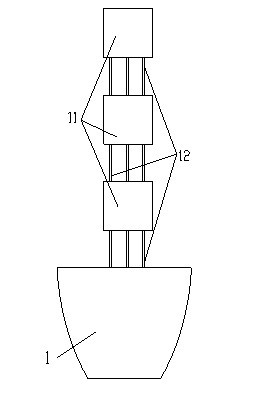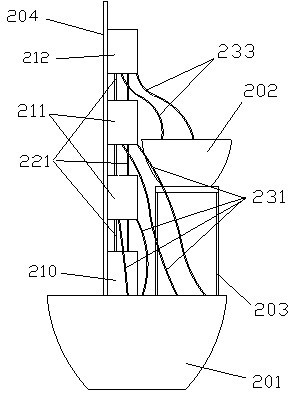Tree grafting method
A tree and rootstock technology, applied in the field of plant grafting, can solve problems such as inability to use, and achieve the effects of improving reliability, improving survival rate, large social value and economic value
- Summary
- Abstract
- Description
- Claims
- Application Information
AI Technical Summary
Problems solved by technology
Method used
Image
Examples
no. 1 example
[0023] The first embodiment: peach tree apricot tree sixfold grafting
[0024] See attached figure 2 , with figure 2 is a schematic diagram of this embodiment.
[0025] as attached figure 2 As shown, in this embodiment, a peach tree main root anvil, two peach tree thick grafting sections, and an apricot tree thick grafting section are vertically grafted together by three groups of nine fine grafting sections to form a peach tree and apricot tree six Focus on the main grafting, and then use four peach saplings and two apricot saplings as auxiliary seedlings for auxiliary grafting. Three main grafting sections counting upwards from the main root anvil are called the first thick grafting section, the second thick grafting section, the third thick grafting section successively, and the third thick grafting section is an apricot tree section. Each group of three thin grafting sections grafted at the lower ends of the first, second, and third thick grafting sections is called...
no. 2 example
[0039] Second embodiment: the composite six-fold grafting of peach trees
[0040] See attached image 3 , with image 3 is a schematic diagram of this embodiment.
[0041] as attached image 3 As shown, the present embodiment uses two flower pots and one flower pot frame, i.e. the second large flower pot 301 and the second small flower pot 302, the second flower pot frame 303; two identical support rods 304 and 305; 8 Two taproot anvils 311 with a diameter of 1 cm; six thick grafting sections 321 with a diameter of 8 cm; twelve fine grafting sections 331 with a diameter of 0.8 cm to 1.2 cm and a length of 18 cm to 20 cm; diameters of 0.8 cm to 1.2 cm, Long 22 centimeters ~ 25 centimeters are used for compound grafting 332 six fine grafting sections; 341 auxiliary seedlings 12.
[0042] All grafting sections and auxiliary seedlings of this embodiment are all taken from peach trees. The selection of main grafting sections and auxiliary seedlings, main grafting, auxiliary gra...
no. 3 example
[0047] The third embodiment: frustum-shaped ginkgo landscape tree 1
[0048] The main grafting section and auxiliary seedlings of the ginkgo landscape tree of the present embodiment are all taken from ginkgo trees. The main body of the trunk is an upright truncated conical cage with a height of 4 meters, a bottom diameter of 1.5 meters, and a top diameter of 1.0 meters.
[0049] 1. The special device for grafting used in this embodiment
[0050] See attached Figure 4 , with Figure 4 It is a structural schematic diagram of the special device for grafting in this embodiment.
[0051] The special device for grafting in this embodiment includes a modeling support component and an auxiliary nutrition container.
[0052] The modeling supporting part of this embodiment is fixedly placed on a stable foundation pile on the ground. The modeling supporting part is generally in the shape of an upright frustum of conical frame with a height of 4 meters, a diameter of 1.5 meters at the...
PUM
| Property | Measurement | Unit |
|---|---|---|
| Diameter | aaaaa | aaaaa |
Abstract
Description
Claims
Application Information
 Login to View More
Login to View More - R&D Engineer
- R&D Manager
- IP Professional
- Industry Leading Data Capabilities
- Powerful AI technology
- Patent DNA Extraction
Browse by: Latest US Patents, China's latest patents, Technical Efficacy Thesaurus, Application Domain, Technology Topic, Popular Technical Reports.
© 2024 PatSnap. All rights reserved.Legal|Privacy policy|Modern Slavery Act Transparency Statement|Sitemap|About US| Contact US: help@patsnap.com










